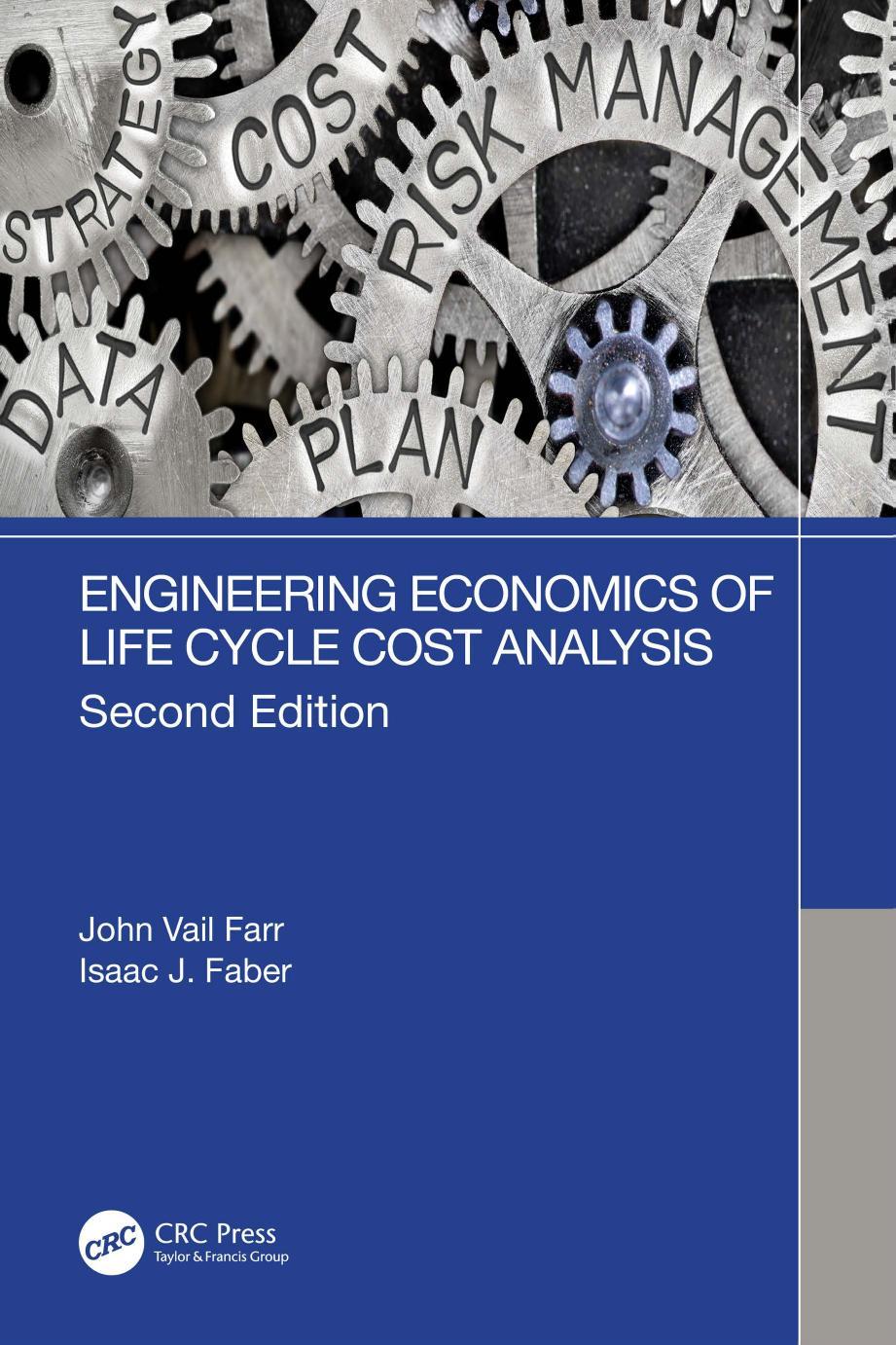Engineering Economics of Life Cycle Cost Analysis
Second Edition
John Vail Farr
Isaac J. Faber
Designed cover image: Shutterstock
Second edition published 2023 by CRC Press
2385 Executive Center Drive, Suite 320, Boca Raton FL 33431 and by CRC Press
4 Park Square, Milton Park, Abingdon, Oxon, OX14 4RN
CRC Press is an imprint of Taylor & Francis Group, LLC
© 2023 John Vail Farr and Isaac J. Faber
First edition published by CRC Press 2018
Reasonable efforts have been made to publish reliable data and information, but the author and publisher cannot assume responsibility for the validity of all materials or the consequences of their use. The authors and publishers have attempted to trace the copyright holders of all material reproduced in this publication and apologize to copyright holders if permission to publish in this form has not been obtained. If any copyright material has not been acknowledged please write and let us know so we may rectify in any future reprint.
Except as permitted under U.S. Copyright Law, no part of this book may be reprinted, reproduced, transmitted, or utilized in any form by any electronic, mechanical, or other means, now known or hereafter invented, including photocopying, microfilming, and recording, or in any information storage or retrieval system, without written permission from the publishers.
For permission to photocopy or use material electronically from this work, access www.copyright.com or contact the Copyright Clearance Center, Inc. (CCC), 222 Rosewood Drive, Danvers, MA 01923, 978750-8400. For works that are not available on CCC please contact mpkbookspermissions@tandf.co.uk
Trademark notice: Product or corporate names may be trademarks or registered trademarks and are used only for identification and explanation without intent to infringe.
Library of Congress Cataloging‑in‑Publication Data
Names: Farr, John V., author. | Faber, Isaac, author.
Title: Engineering economics of life cycle cost analysis / John Vail Farr, Isaac J. Faber.
Description: 2nd edition. | Boca Raton : CRC Press, [2023] | Includes bibliographical references and index.
Identifiers: LCCN 2022059215 (print) | LCCN 2022059216 (ebook) | ISBN 9781032184869 (hbk) | ISBN 9781032184876 (pbk) | ISBN 9781003254782 (ebk)
Subjects: LCSH: Life cycle costing. | Engineering economy. | Systems engineering--Cost effectiveness.
Classification: LCC TA177.7 .F368 2023 (print) | LCC TA177.7 (ebook) | DDC 620.0068/1--dc23/eng/20221212
LC record available at https://lccn.loc.gov/2022059215
LC ebook record available at https://lccn.loc.gov/2022059216
ISBN: 978-1-032-18486-9 (hbk)
ISBN: 978-1-032-18487-6 (pbk)
ISBN: 978-1-003-25478-2 (ebk)
DOI: 10.1201/9781003254782
Typeset in Times by KnowledgeWorks Global Ltd.
SECTION 2
Cost Estimation of Complex Systems
SECTION 3 Cost Management
List of Abbreviations
A annuity
AC actual cost
ACID atomicity, consistency, isolation, and durability
ACWP actual cost of work performed
ADM arrow diagramming method
AEW annual equivalent worth
AI artificial intelligence
API application programming interface
APR annual percentage rate
ASCE American Society of Civil Engineers
ASEM Annual Society of Engineering Management
AWS Amazon Web Services
BAC budget at completion
BCR benefit cost ration
BCWP budgeted cost of work performed
BCWS budgeted cost of work scheduled
CAGR calculated compound annual growth ratio
CASE computer-aided software engineering
CBS certificate breakdown structure
CD certificate of deposit
CDF cumulative distribution function
CER cost estimating relationships
CFD cash flow diagram
CLOC commented lines of code
COCOMO constructive cost model
COCOMO II constructive cost model version II
COCOTS constructive commercial Off-the-Shelf model
CONOPS concept of operations
COSYSMO constructive systems engineering cost model
COTS commercial Off-the-Shelf
CPG continuous process generator
CPI consumer price index or cost performance index
CPM critical path method
CPP conventional payback period
CRUD creating, read, updating, and deleting
CSI cost schedule index
CSP cloud service providers
CUT code and unit test
CV conventional carrier or cost variance
DBMS database management system
DD detailed design
DoD Department of Defense
DPG discrete process generator
DPP discounted payback period
EAC estimate at completion
EAF effort adjustment factor
ELOC effective lines of code
ESOH environmental, safety, and occupational health
ETC estimate to complete
EV earned value
FFP firm-fixed price
FP function points
FV future value
GAC granulated activated carbon
GCP google cloud platform
GOTS government off-the-shelf
GPUs graphical processing units
IaaS infrastructure as a service
IPT integrated product teams
IRAD internal research and development
IRR internal rate of return
IT information technology
ITM inverse transformation method
KDSI thousands of delivered source lines of instructions
KLOC thousands of lines of code
LCC life cycle costs
LCCA life cycle cost analysis
LDC large defense contractor
LIDAR light imaging detection and ranging
LOGPACS logistic packages
M&S modeling and simulation
MACRS modified accelerated cost recovery system
MARR minimum attractive or acceptable rate of return
ML Machine learning
MODA multi-objective decision analysis
MOTS modifiable or military off-the-shelf
MPTs methods, processes, and tools
MRP material requirements planning
NCLOC non-commented lines of code
NAE National Academy of Engineering
NASA National Aeronautical and Space Administration
NFV net future value
NFW new future worth
NIST National Institute of Standards
NPV net present value
NPW net present worth
NSF National Science Foundation
O&M operation and maintenance
O&S operations and support/sustainment
PaaS platform as a service
PCE parametric cost estimating/estimate
PDF probability distribution function
PDM precedence diagramming method
PERT program evaluation review technique
PM program/project management
PMI Project Management Institute
PMP program management professional
PS percent spent
PSM professional staff months
PV planned value
R&D research and development
RDT&E research, development, testing, and evaluation
RDBMS relational database management system
ROI return on investment
SaaS software as a service
SBC simulation-based costing
SE/PM systems engineering/project management
SLOC source lines of code
SoS system of systems
SQL structured query language
SSD solid-state drives
SV systems view or schedule variance
TCF technical complexity factor
TDEV time to develop
TOC total ownership costs
TRL technical readiness level
TVM time value of money
UCP use case points
UFP unadjusted function point
UV ultraviolet
VAC variance at completion
WACC weighted average cost of capital
WBS work breakdown structure
WLC whole life costing
YTM yield to maturity
Preface
The advent of modern computing systems and instantaneous communication, the elimination of low and middle management who tracked and managed information, and the implementation of extremely efficient supply chains has dramatically affected the roles and responsibilities of engineers at all levels. With today’s globalization, technology, and complexity, few engineers or similiar professionals sit at a desk and design at the component level. We are mainly integrators of systems, project/program managers, and utilizers of technology to develop effective and efficient designs. This 21st-century paradigm has given engineers the opportunity to use their technical training and problem-solving skills as points of departure into spiral and rapid prototyping, creation of disruptive products and services, and complex and interdisciplinary product development in non-traditional engineering fields such as sales, law, medicine, and corporate leadership. The future will require systems that are more complex, providing for increased opportunities for engineers to be business leaders first and engineers second. The marketplaces of the information age will require employees at all levels to be both business and tech-savvy. They must be able to develop accurate cost estimates based on defensible cost analysis and manage people and budgets. Even at the component level, engineers must conduct meaningful trade space studies to make informed decisions. Engineers continue to be poised for tremendous career opportunities, but the landscape will require different job skills. It is against this backdrop that we wrote this book.
At the undergraduate level, most engineers are, at best, introduced to engineering economics as their only exposure to the costing and estimating of projects. Many universities introduce economic planning material in some type of capstone class. Few require an entire course on the subject. At the graduate level, most programs are domain-centric and may not deliver any exposure to cost estimation and management, especially at the systems level. Engineers must pursue an MBA or learn the appropriate skills via on-the-job training to become competent in business affairs. Unfortunately, the courses traditionally taught in an MBA program—mainly strategy, finance, and accounting—do not provide the skills needed to be a program/ product manager or a leader of an integrated product team (IPT), to bring products to market on time and within budget, to understand the true costs of the product, and to conduct trade-off or trade space analysis. Thus, most engineers are ill prepared to enter and excel in the job market and work on interdisciplinary projects where cost analysis, estimation, and management skills are not only valued but required. Our formal training has failed us; we must learn the requisite costing, accounting, and management skills via on-the-job training or return to school to pursue a business or related degree.
There are some outstanding and very mature engineering economics textbooks in the marketplace. The methods, processes, and tools (MPTs) presented in these textbooks are as relevant now as they were 20 years ago. Most of the leading textbooks do an outstanding job of presenting the mechanics of engineering economics. However, the work environment has dramatically changed; it now requires more
than simply understanding the mathematics of engineering economy. First and foremost, engineers often enter the market as leaders of IPTs. Often early in their career they are responsible for on-time and on-budget products that are produced by interdisciplinary teams across multiple time zones. They are responsible, in part or directly, for profit and loss at all levels or products/services development. Technology has increased productivity and the span of control. When combined with complexity, risk is also increased. Few engineers have the luxury of becoming component-level experts and assuming more responsibility as their level of experience grows. Thus, entry-level and junior engineers need more than the math of engineering economics; they need to understand the business of being an engineer. Traditional engineering economics should be one of the tools at their disposal. They must understand not only how to make capital investment decisions throughout a product life cycle but also the economics of operating a business, contracting, complex analysis techniques, and, more importantly, making risk trade-offs.
The first edition of this book was a textbook adaption, evolution, and updating of the “Systems Life Cycle Costing: Economic Analysis, Estimation, and Management,” published in 2011. Though marketed as a reference book, it was adopted by many universities as a text for graduate classes in engineering economics. Thus, the motivation for the first edition. Unlike the mature knowledge encompassed by the traditional engineering disciplines, the techniques and tools for costing complex systems are rapidly evolving and being driven mainly by the commercial sector. Modern engineers need MPTs beyond classic engineering economics, must understand life cycle cost analysis (LCCA), and must apply these to complex systems to include infrastructure, cars, planes, information technology systems, etc. First and foremost, we are interested in the cost analysis, estimation, and management of systems. Though components are important, the more challenging and relevant problems are systems. Secondly, engineers must worry about life cycle or total ownership costs (TOC) and not simply development costs. All too often, we only cost our piece of the life cycle and do not make sound TOC acquisition decisions using quantifiable and defendable analysis. Lastly, an engineer must be able to conduct economic analysis, estimate the cost of the system, lead/manage people and resources, and understand the “big picture” as part of the business enterprise. Also, the MPTs and techniques are often not presented in the open literature at the systems level because of the competitive advantage afforded any company that can accurately estimate their life cycle costs (LCCs). Thus, much of the MPTs were gleamed from government sources especially the Department of Defense (DoD) and the National Aeronautical and Space Administration (NASA). This was not our desire; however, the DoD and NASA are in many ways are the intellectual thought leader on costing and estimating of complex systems because of the sheer size and complexity of their projects/ programs.
When Dr. Farr wrote the original LCCA reference in 2011, he had hoped to improve on the engineering economy material taught in most engineering programs. He also hoped that book could also be used in graduate programs in engineering management, mechanical engineering, systems engineering, etc. As we collected feedback from students and other customers, we became convinced that this was the
right set of MPTs and should replace engineering economy at both the undergraduate and graduate level. Thus, we wrote the 2019 LCC textbook which was the first edition of this text. In our software-centric workplace, Dr. Faber is able to bring some modern relevance to the traditional engineering economic topics based upon his software and data science background. First and foremost, tools like Excel and @Risk have made teaching real-world cost problems possible. Secondly, most engineers work in an interdisciplinary world and must understand TOC of their products. Entry-level engineers simply need more than the mathematics of the time value of money to succeed that is taught in traditional engineering economics classes/lectures. Life cycle costing is at best an immature industry-driven discipline. Unfortunately, textbooks are often long on theory and short on meaningful examples, real data, etc.
The 2nd edition of the 2019 textbook was developed with several goals. First and foremost, we wanted to introduce new material because of the rapid advances in data analytics, big data, and software-centric systems. Thus, we added a new chapter on costing data and advanced computational methods with details on such subjects as cloud versus distributed systems and the role of costing in artificial intelligence/ machine learning. We also added a chapter on integration cost, value, and schedule to better perform trade space studies. Secondly, we wanted to correct all of the many errors and add additional problems. One of the criticisms of the original text was that many of the problems were too challenging. We originally tried to present as many real-world problems as possible. Many of the new problems that were added were designed to demonstrate the techniques in lieu of applying them to a real-world problem. Lastly, we added an appendix of how to use the economic functions in Excel. Most of the examples in the text have been updated to demonstrate the functionality of Excel in lieu of the traditional solution methods of equations and table lookup.
Our former colleagues at West Point along with the students and faculty at Stevens Institute of Technology, University of Central Florida, Clarkson University, and Stanford University contributed to much of the material presented herein. Having made every effort to correctly reference the material, we suspect there are phrases and other elements of the book that are not properly referenced. If you encounter a phrase, figure, etc., that is not correctly referenced please send us the correct information. Also, please send us any ideas, problems, mistakes, new material, etc. Note that we are maintaining the website www.systemscosting.com. This is a great way to contact us, provide feedback, etc.
John
V. Farr Professor Emeritus
United States Military Academy at West Point
Isaac J. Faber Chief Data Scientist United States Army

















